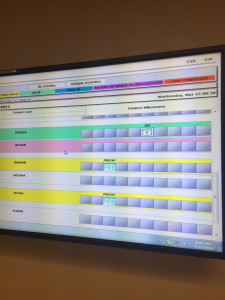Carwash Part 4: The Same-Day Surgery Waiting Room
In three previous posts — A Lesson In Client Communications…From The Car Wash, Carwash Part 2: Samples Of Client Status Worksheet, and Carwash Part 3: An Example From Music Publishing, we discussed the importance of providing customers with access to the status of their projects. Why should we keep a customer in the dark about what’s going on behind the scenes in a huge project of importance to them when something as simple as a car wash lets her watch every stage of the process?
The board pictured is an example of this principle in action. It’s located in the family waiting room of the same-day surgery unit of a large city hospital, and family members can see at a glance whether the patient is is in pre-op, in surgery, in the recovery room, or in one of several transitional stages in between. Every stage of the process is color coded, and the patient names are coded for privacy. (The family of John Smith, whose birthday is the 20th day of his birth month, would find his information on the line that starts with SM20JO.)
No matter what business you’re in, when a customer gives you some work to do, she’s essentially saying “I trust you to help me get from Point A to Point B.” But unless it’s something done before her very eyes, like building an addition onto her house, or giving her a haircut or manicure, at least some of the work will be done out of sight. What questions are running through the mind of your customer while you’re busily working hard on the project?
- Is progress being made?
- Are things are going as expected?
- Have any problems been encountered along the way and, if so, what’s being done to address them?
Don’t you want to manage the expectations of customers — to anticipate and answer their questions before they ask them?
Any “car wash” type status reporting system should have the following characteristics:
- Easy to access. Your customer shouldn’t have to work too hard to get to it. The same-day surgery status board is ideal in this respect because it’s a big screen right in the waiting room. There’s no sign-on to a site required.
- Easy to understand. Use color coding and graphics when possible. Made sure any abbreviations are either obvious or spelled out in an easy-to-find explanation. The same-day surgery board gets high marks for the colors and graphical format, but slipped on the abbreviations: Not everyone in the room figured out the naming convention: It would have helped to have an explanation and example printed near the screen, such as “Name of your family member is coded with first two letters of last name–day of the month–first two letters of first name as in Mary Jones born August 19 = JO19MA.”
- Up-to-date. Nobody likes it when the information is outdated. Once you make a commitment to a status board, you have to commit to keeping it current.
Every customer who puts her trust in us to perform work for her deserves to be kept informed. When you build your status system, keep these principles in mind.

